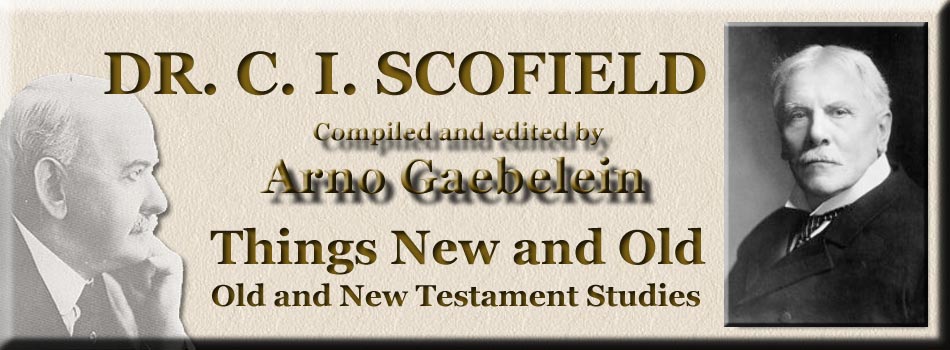
Things New and Old
By Cyrus Ingerson Scofield
Compiled and Edited By Arno Clement Gaebelein
THE MESSAGE OF THE RISEN CHRIST.(Rev. i:10-20.) I. The Analysis. 1. The command to write. Verses 10, 11. 2. The Patmos vision. Verses 12-20 (see "Heart"). II. The Heart of the Lesson. The lesson title is inexact. What we have in this lesson is not a message of the risen Christ, but a vision of the risen Christ himself. The message follows in chapters ii to xxii. It is significant that John, the beloved disciple whom we count to have been most intimate with Jesus, who reclined on His breast at the last supper, who had walked and talked with Him, fell at His feet as one dead when he saw the risen Christ in His glory. It should provoke inquiry. It is not the heart of this lesson and so I pass it with some questions for our further thought. Is He not the unchanging One, "that same Jesus?" Undoubtedly. Why, then, did John w^ho knew Him so well find the revelation of His glory so overpowering? Was it not because John then for absolutely the first time saw Him as He essentially is? In the mount of transfiguration John had seen Him in the glory of the millennial kingdom; a glory subdued to the capacity of man to behold it; now he saw ''that same Jesus in the glory which He had with the Father before the world was." And, ought we not to pray and worship in the full sense of all that has been revealed concerning our adorable Lord? In the gospels we have His glory veiled in the humanity of the Carpenter; in the Patmos vision we have His glory unveiled, and these two portraits blend, or should blend in our thought of Him. Because He is the gentle One of Galilee and Judea we will come into His very arms; but because He is the infinite God we will come reverently. There was no "dear Jesus" and ''sweet Jesus" that day on Patmos. But we are, I think, to find the heart of this lesson in what John saw that wonderful Lord's day when he was in the Spirit. He saw the risen Christ in the plenitude of divine power and glory in the midst of the churches. He wore His highpriestly robes, signifying intercession (Heb. vii:24, 25), and a girdle, which always signifies service. Thus clothed and girded, He was in the midst of His churches on earth. As such, and as there, we are to conceive Him through this whole dispensation. And He gives these churches on earth a most significant name. He calls them "golden candlesticks," or "lamp-stands." It is at once a definition and a test. A lampstand is something which exists for a purpose—to hold up a light. It does not exist for its own sake. Christ is the Light of the world, and the business of His lampstands is to hold Him up. When the churches become self-conscious, self-centred, they are sure to attract attention to themselves, not to the Light. Minot's Ledge Light is a wonderful triumph of engineering skill, but its business is to hold up Boston Light, and the storm-tossed mariner who catches its beckoning gleam through the darkness of the tempest and makes the harbor which he had despaired of, thinks little of the tower, but much of the light. When the eloquence of the preacher, or the magnificence of the architecture, or the beauty of the stained glass windows, or the attractiveness of the choir have come to be the things for which a church is most remarked, we may be sure the Light is lowered, or dimmed, or withdrawn. And these candlesticks were of gold, and gold is the symbol of divine righteousness. The Light of the world is to be held aloft in no compromise with the world which is at once to enlighten and rebuke. It admits of no use of tainted money; no offering of that which is unclean on the altar of the Lord. But how blessed that the risen Christ is in the midst of the candlesticks even though they are very faulty; even though He is immediately to raise many a searching issue with them. Ephesus had left first love; Pergamos had settled down comfortably in the world; Thyatira was married to the heathen Jezebel; Sardis had a name to live and was dead, and Laodicea was a disgust to His holy soul, but He is still in the midst of the churches. In these churches we have a prophetic foreview of the seven phases through which the church on earth is to pass; and it is most solemn that in the last or present phase the risen Christ is outside the door. With the self-satisfaction and self-glorification of Laodicea He has no part.
|
|
 |
 |
|
|
|
-
Site Navigation
 Home
Home What's New
What's New Bible
Bible Photos
Photos Hiking
Hiking E-Books
E-Books Genealogy
Genealogy Profile
Free Plug-ins You May Need
Profile
Free Plug-ins You May Need
 Get Java
Get Java.png) Get Flash
Get Flash Get 7-Zip
Get 7-Zip Get Acrobat Reader
Get Acrobat Reader Get TheWORD
Get TheWORD